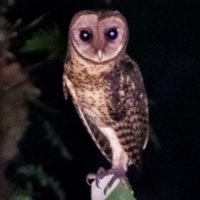Introduction
The Golden Masked Owl is a relatively small barn owl with no ear-tufts. It is also known as the New Britain Masked Owl or New Britain Barn Owl.
Photo Gallery (1 picture)
Information
Description:
The facial disc is pale yellowish-brown, with a finely dark-speckled reddish-brown rim. Eyes are blackish-brown, and the bill is ashy-white.
Plumage overall is pale golden-rufous, darker on the back.
Primaries, secondaries and tail feathers have some dark brown bars, the primaries having a dark spot near the tips.
Upperparts have dark brown V-shaped markings which are rather large on the wing-coverts and back, but smaller on the hindneck and crown.
Inside these V-shaped markings is a pale patch with a dark spot, with is prominent on the wing-coverts and back.
Underparts are slightly paler than upperparts, with dark brown, indistinctly heart-shaped spots.
Legs are long, feathered pale orange-brown down to the base of the bare toes which are yellowish-grey to brownish-grey. Claws are brown, becoming darker towards the tip.
Size: Length 27-33cm. Wing Length 220-230mm. Tail Length around 99mm. Weigh unknown.
Habits: Unknown
Voice: Utters a long ascending ka-ka repeated about 6 times per second. Hissing and screeching notes are also reported.
Hunting & Food: Feeds on small rodents. Likely takes other small vertebrates and insects.
Breeding: The breeding biology of the Golden Masked Owl is unknown.
Habitat: Tropical rainforest with clearings, ravines with trees and shrubs. Found from lowlands up to about 1830m above sea level.
Distribution: Endemic to the island of New Britain in Papua New Guinea.

Range of the Golden Masked Owl Tyto aurantia
Status: Uncommon to rare, Listed as vulnerable by Birdlife International.
Original Description: Salvadori, Tomaso. 1881. Atti Reale Accademia della Scienze di Torino, 16, p. 94-95.

